- Home
- Sustainability
- Creating a society that co-exists with the environment
- Aiming to Achieve Net Zero by 2050
Aiming to Achieve Net Zero by 2050
Direction of Initiatives Toward Net Zero
Our Group is committed to achieving net zero in 2050*1 by focusing on a "Reduction of GHG emissions" and "Promotion of circular economy." Specifically, we will implement energy conservation measures in our stores, expand the use of renewable energy, and reduce Scope 3 GHG emissions (hereinafter referred to as "Scope 3 emissions") through collaboration with our suppliers and customers. Additionally, we will promote resource recycling through measures such as strengthening the 3Rs*2 (Reduce, Reuse, Recycle) and expanding circular business models.
![[JFR Group Net Zero by 2050] 【Reduction of GHG emissions】Scope 1 & 2 reduction by expanding renewable energy, Scope 3 reductions in collaboration with suppliers 【Promotion of circular economy】Waste reduction, recycling, expansion of circular business model](/english/sustainability/low-carbon/low-carbon02/low-carbon02_2510-01.jpg)
Targets
The Company recognizes that setting ambitious medium and long-term reduction targets and developing a roadmap to achieve them is necessary to promote climate change countermeasures across the Group. Based on this, we obtained certification through the Science Based Targets (SBT) initiative*3 in 2019 for our Scope 1, 2, and 3 greenhouse gas emissions reduction targets. In 2021, we reacquired SBT certification with a "1.5℃ target," raising our 2030 Scope 1 and 2 GHG emissions reduction target from 40% to 60% As of the end of February 2025, we had already achieved our 2030 target of a 60% reduction in Scope 1 and 2 emissions ahead of schedule, reaching a 65.4% reduction. As a result, we have raised our 2030 reduction target to 73%.
*1. A thorough reduction of GHG emissions, with the remaining emissions being reduced to practically zero after subtracting the amount removed through forest absorption, CCS (CO2 capture and storage), etc.
*2. 3Rs stand for Reduce, Reuse, and Recycle.
*3. The Science Based Targets initiative was established jointly in 2014 by CDP, the UN Global Compact, the World Resources Institute (WRI), and the World Wide Fund for Nature (WWF) to enable companies to set ambitious emission reduction targets in line with the latest climate science.

JFR Group 2050 Net Zero Transition Plan
Recognizing the need to take a medium- to long-term approach in order to achieve net zero by 2050, we have formulated a transition plan toward that goal. Based on the results of our analysis of climate-related risks and opportunities, as well as their financial impacts, we will implement appropriate countermeasures to address risks and actively respond to changing customer needs that represent new opportunities. In this way, we will promote specific initiatives from short-, medium-, and long-term perspectives, aiming to capture new growth opportunities. Furthermore, by integrating investment and funding plans with fiscal year initiatives in the transition plan, we will clarify the connections between these elements and enhance the plan's effectiveness.
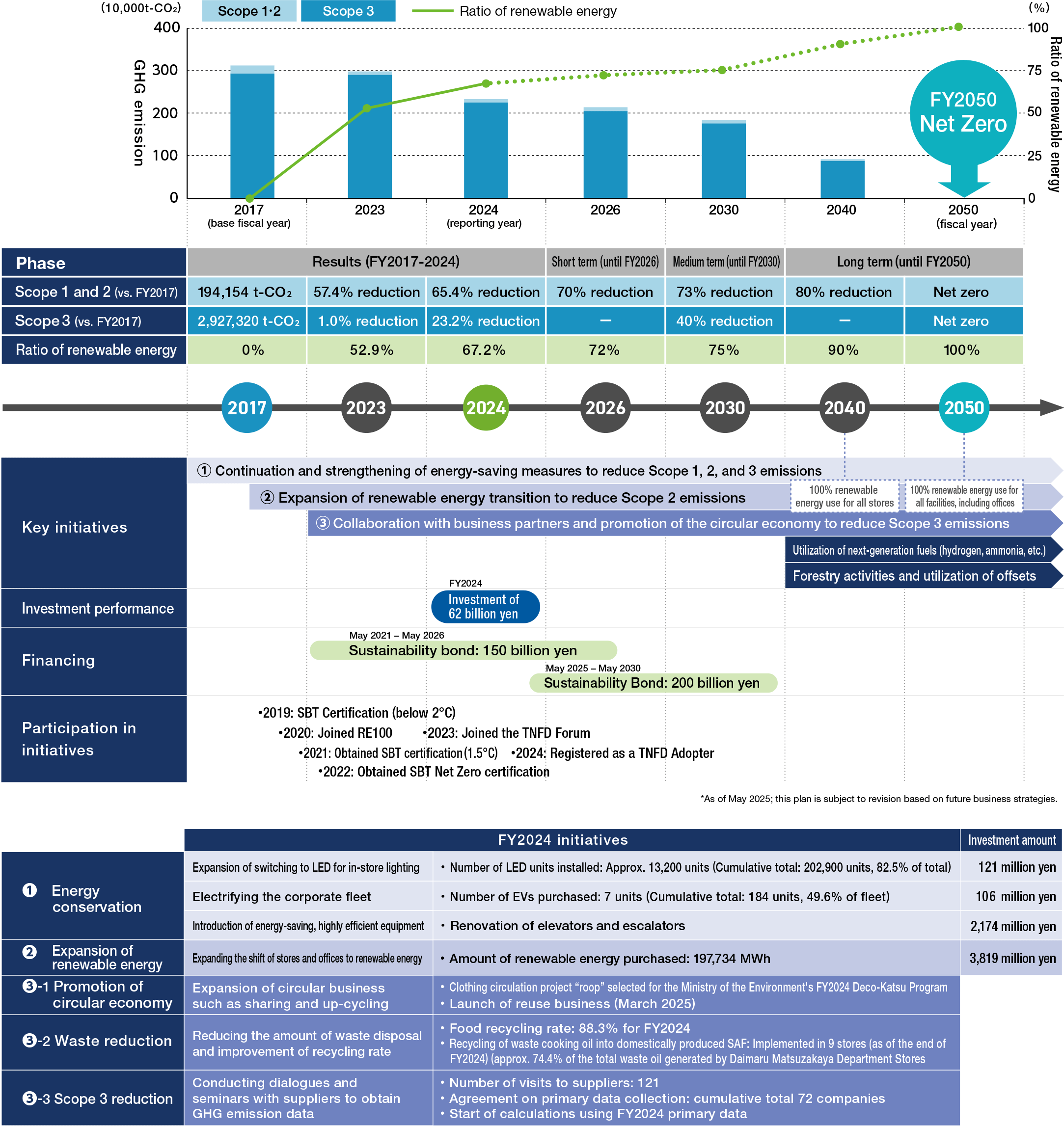
Expanding Use of Renewable Power for Sustainable Stores
In our Group, whose business centers on retail such as department stores and shopping centers, over 90% of Scope 1 and 2 emissions come from our stores, and approx. 80% of those emissions are attributable to electricity use. Therefore, we recognize the need to both improve energy efficiency and promote energy saving, as well as transition to renewable energy for the electricity used in stores.
Starting with the opening of the Daimaru Shinsaibashi store in 2019, which operates entirely on renewable energy, we have been gradually switching our stores in the Kansai, Kanto, ad Chubu regions to renewable energy. In April 2024, we implemented the transition to renewable energy at the Daimaru Umeda store. As a result, in FY2024, our renewable energy ratio reached 67.2%, and our Scope 1 and 2 emissions were reduced by 65.4% compared to the base year of FY2017. Furthermore, as of the end of February 2025, we had already achieved our Scope 1 and 2 emissions reduction targets of 60% and renewable energy ratio target of 60%, which had been set for 2026 and 2030, well ahead of schedule. Accordingly, we have now set more ambitious targets for 2030.
We believe that operating stores with renewable electricity enhances the environmental value of our buildings and contributes to gaining support from environmentally conscious suppliers and customers. We will continue to promote the transition to renewable electricity going forward.
Change in ratio of renewable energy usage
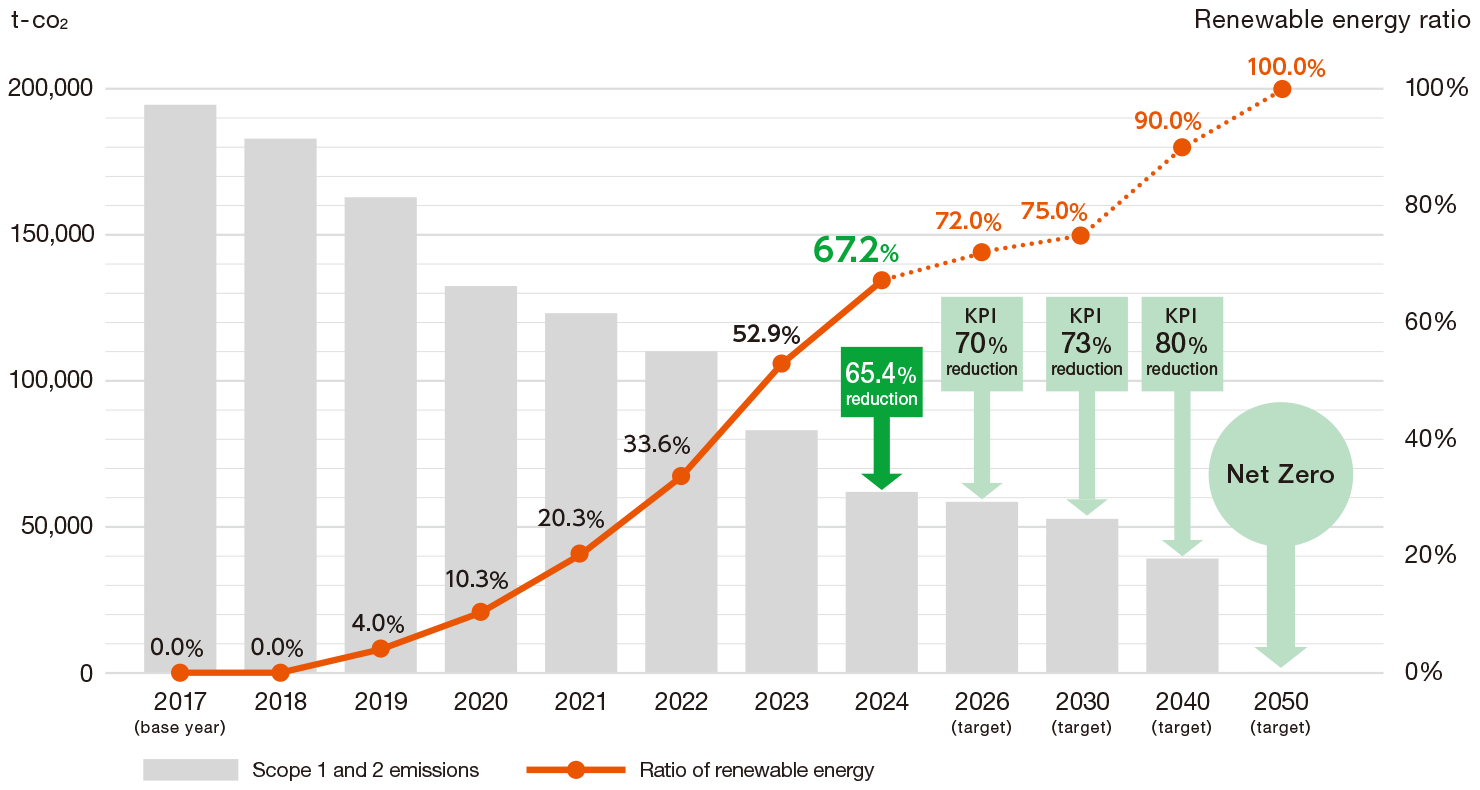
Major stores switching to renewable energy (as of 02/28/2025)
Daimaru & Matsuzakaya |
PARCO |
|---|---|
| Shinsaibashi / Umeda / Kyoto / Kobe / Suma / Nagoya (excl. North Building) / Ueno / Shizuoka / Takatsuki (9 out of 15 stores) |
Sapporo/Sendai (excl. main store) / Ikkebukuro / Ueno / Kichiijoji / Chofu / Shizuoka / Nagoya / Shinsaibashi / Hiro-shima / Fukuoka / Hibarigaoka / Matsu-moto (13 out of 16 stores) |
Contributing to the spread of renewable energy
Solar panels have been installed on the rooftops of Shibuya PARCO and Kyoto Zero Gate to generate their own electricity. In the future, we will work to introduce additional* renewable power procurement and improve energy resilience by diversifying our procurement sources.
* Contribute to the spread and expansion of new renewable power sources and be effective in reducing CO2 emissions
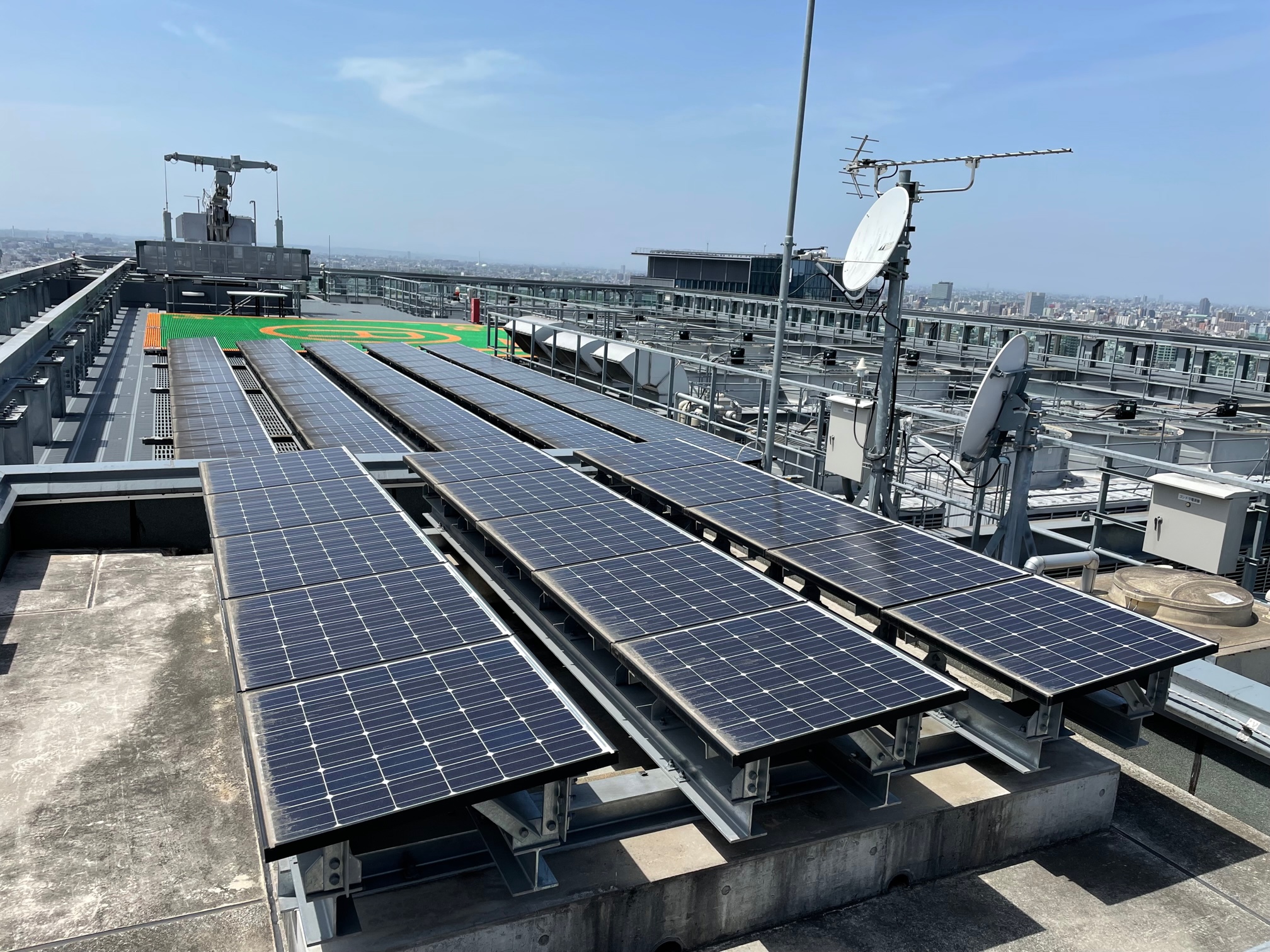
Expansion of Electric Vehicle (EV) Charging Stations
Angel Park, a Group company that operates parking facilities, has installed a total of 10 EV charging stations that customers can use free of charge. Since April 2023, Angel has switched to 100% renewable energy for electricity throughout the building, which will not only improve convenience for customers using electric vehicles but also contribute to the decarbonization of society.
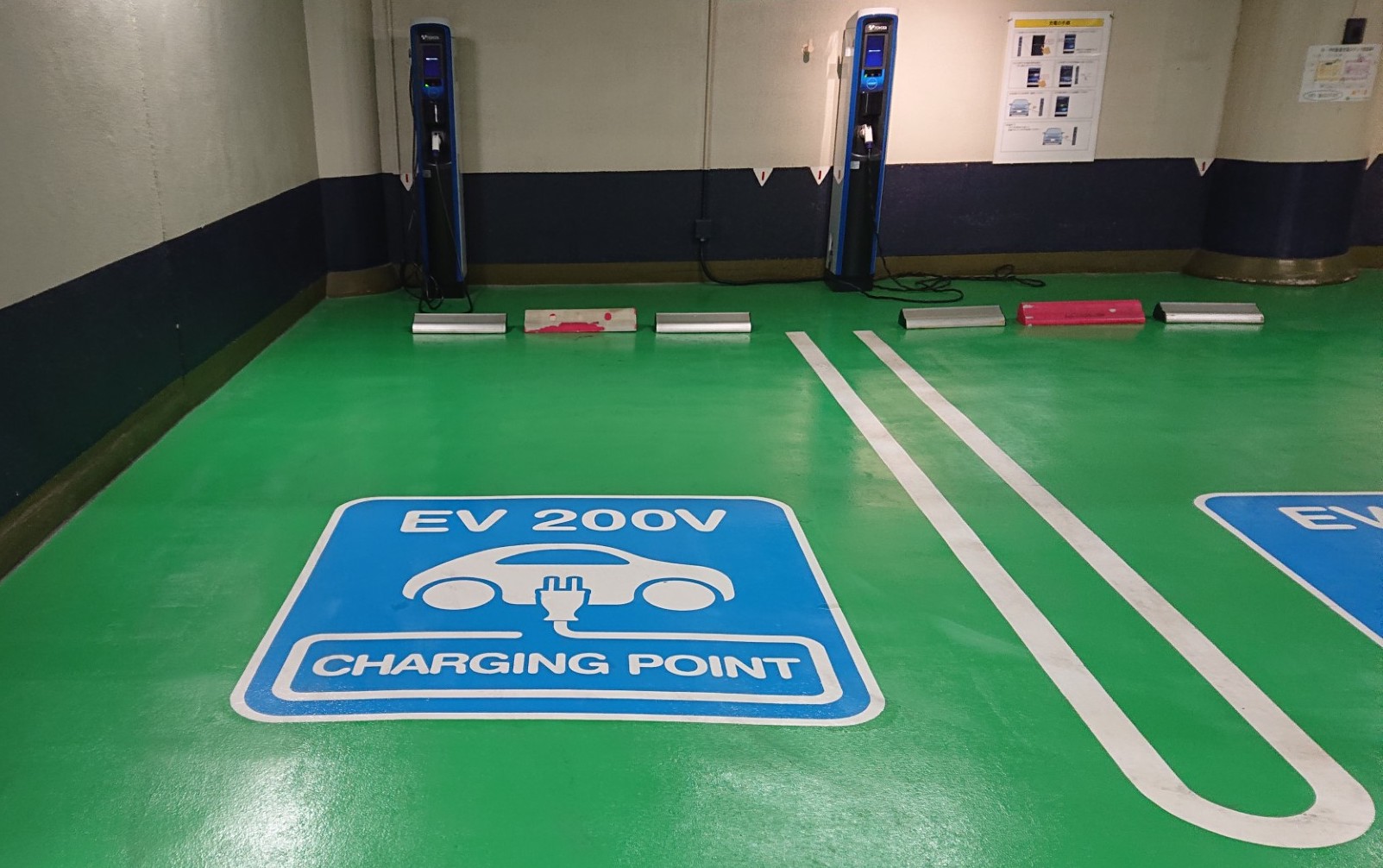
Energy-saving initiatives
Instructions and Responses to Public Regulations
The Group supports laws, regulations such as the “Act on Promotion of Global Warming Countermeasures (Global Warming Act)” and the “Act on Rationalization of Energy Use and Shift to Non-fossil Energy (Energy Conservation Act)”, and policies related to climate change and reducing energy consumption. As a result, are working on various energy-saving initiatives.
New Shibuya Parco-an environmentally friendly next-generation building
Shibuya Parco, which opened on November 22, 2019, has been selected for the Ministry of Land, Infrastructure, Transport and Tourism’s “Sustainable Building Leadership Project (CO2 Leadership Project)” for its efforts to (1) create attractive outdoor spaces including a roof top square and multi-level pathways; (2) actively introduce high-efficiency energy systems including a cogeneration system (CGS)*; and (3) promote the efficient use of energy through digital communication technology. In addition to installing the latest equipment and fixtures, we also “visualized” energy efficiency for energy management systems to make the building a multi-purpose commercial space showcasing efficient energy use with lower CO2 emissions.
* Cogeneration system (CGS): System that simultaneously produces and supplies electricity and heat from a single energy source

an environmentally friendly
next generation building
Introduction of energy-efficient equipment and promotion of LED conversion
The Group adopts various energy-saving measures to reduce CO2 emissions and prevent global warming. We are gradually introducing energy-efficient equipment when updating or renovating facilities and opening new stores.
Daimaru Matsuzakaya Department Stores and PARCO are striving to reduce electricity consumption and CO2 emissions by replacing existing lighting with LED units. In FY2024, approximately 13,200 lighting units were switched to LED, bringing the cumulative total to 202,900 units.
* Reduction of CO2 emissions in FY2024 from LED conversion: approx. 10,145 t-CO2 per year.
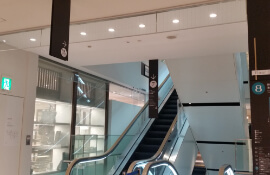
(Daimaru Tokyo store)
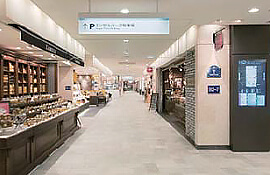
(“Table Plus,” food floor of Matsuzakaya
Nagoya store)
Electrifying the corporate fleet
In FY2024, Daimaru Matsuzakaya Department Stores switched 7 of its vehicles to EVs, bringing the total number of EVs in operation to 184 (49.6% of total). We will continue to promote the conversion of company vehicles to EVs to reduce CO2 emissions.
Since 2011, Daimaru-Matsuzakaya has adopted "telematics" (mobile communications) for its fleet of independently operated vehicles. Telematics" is a system that collects data on how employees operate the vehicles, such as excessive speed, sudden acceleration/deceleration, and fuel consumption. The Safety Operation Committee meets once every three months and uses the telematics data to improve fuel efficiency and implement eco-driving and safe driving that produces less low CO2 emissions.
Supplier Engagement Toward Scope 3 Reductions
More than 87% of our Scope 3 emissions fall under Category 1 (purchased goods and services), making it difficult to achieve re-ductions through our own efforts alone. Therefore, reductions must be pursued through collaboration across the entire value chain.
To date, our core operating company, Daimaru Matsuzakaya Department Stores, has engaged in dialogue with business partners based on their specific circumstances, covering areas such as calculating emissions, setting reduction targets, and requesting primary data related to emissions (Scope 1, 2, and upstream Scope 3). As of FY2024, we have held discussions with a total of 121 companies, and reached agreement on the provision of primary data with 72 companies.
In FY2024, we incorporated data from 41 companies that calculated their Scope 1, 2, and 3 emissions and obtained third-party assurance as primary data into our Group's calculations. As a result of reflecting our suppliers' reduction efforts, our Category 1 emissions decreased by 26.9% compared to FY2023.
Furthermore, Daimaru Matsuzakaya Department Stores actively participated in the formulation of the "Guidelines on the Use of Primary Data for Scope 3 Category 1 Supply Chain Emissions in the Department Store Industry" and the "Scope 3 Calculation For-mat," both initiatives spearheaded by the Japan Department Stores Association. Through these initiatives, we contributed to driving decarbonization efforts across the department store industry's entire value chain.
To enhance the efficiency and pace of these efforts, we transitioned to a new environmental data calculation system in March 2025. By utilizing this system and further strengthening collaboration with our suppliers, we will continue to advance our initiatives to reduce Scope 3 emissions.
Scope 3 Category 1 Reduction
![FY2023 : 26.79 million t-CO₂ FY2024 : 1,959 million t-CO₂ (Calculated using primary data) (Calculated using emission intensity based on industrial interconnection tables : 2,833 million t-CO₂) [26.9% reduction, Reflecting reduction efforts by suppliers] * For FY2024, we calculated Scope 1, Scope 2, and upstream Scope 3 emissions, and converted the data from 41 companies, verified by third-party assurance, into primary data](/english/sustainability/low-carbon/low-carbon02/low-carbon02_2510-05.png)
Previous initiatives toward the value chain
(Daimaru Matsuzakaya Department Stores)
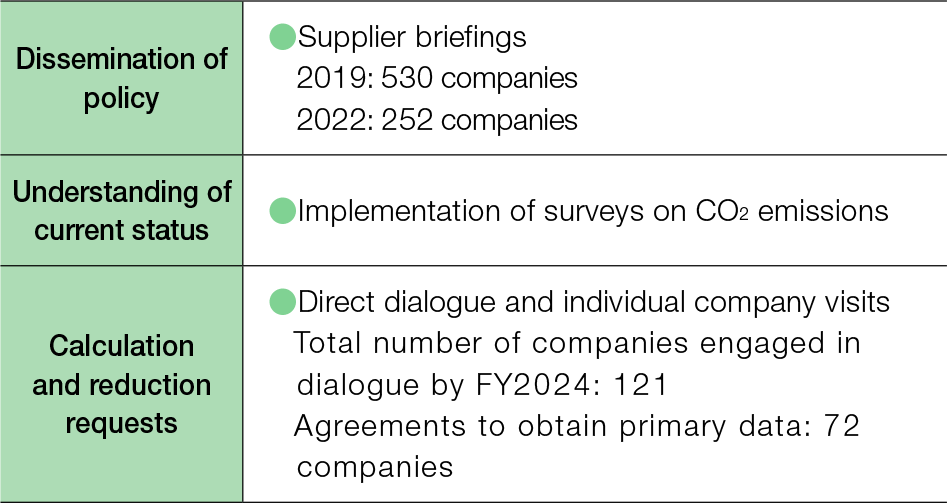
Scope 3 Emissions
![FY2017 (base fiscal year) : 293 million t-CO₂ FY2024 : 225 million t-CO₂ FY2030 (Target) : 176 million t-CO₂ [40% reduction (vs. FY2017)]](/english/sustainability/low-carbon/low-carbon02/low-carbon02_2510-07.png)
FY2024 Scope 3 Emissions by Category
(unit: t-CO2, %)
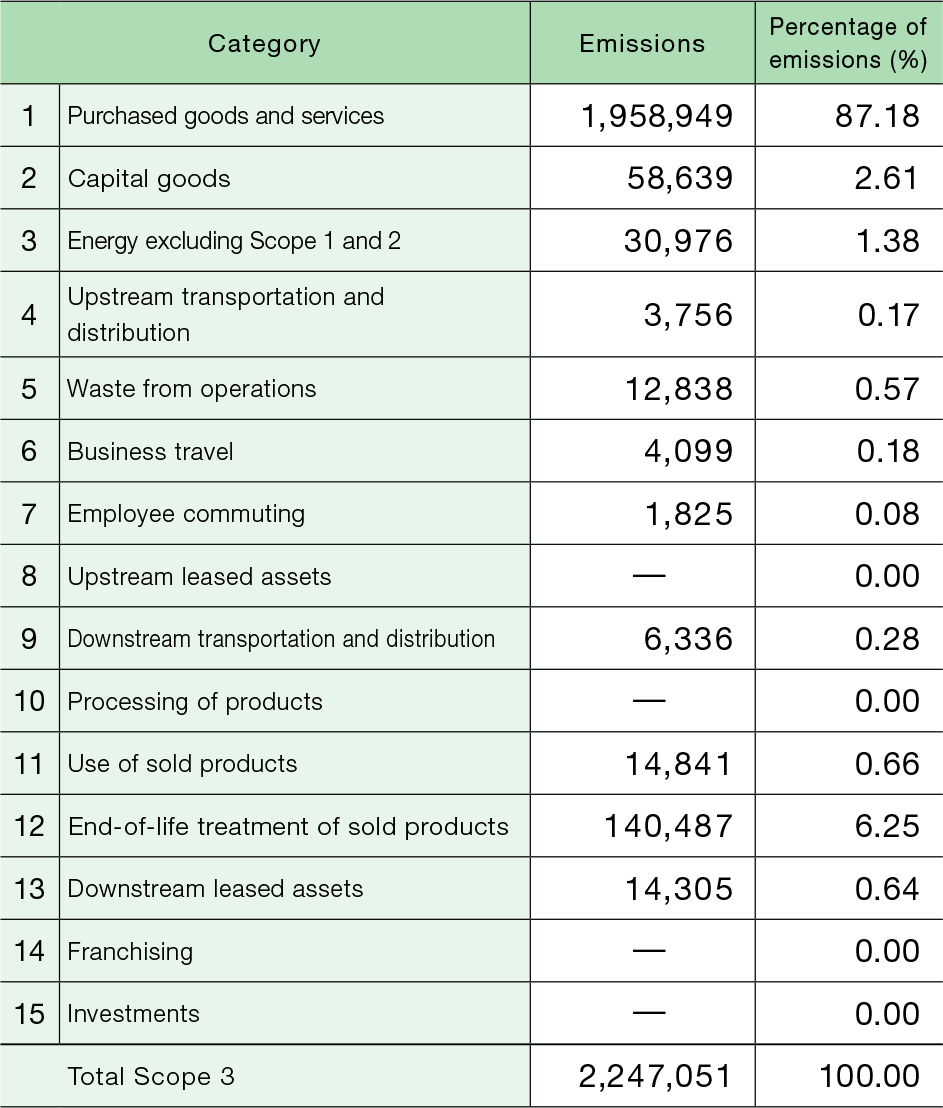
* Category 8 is excluded from the calculation because it is calculated under Scope 1 and 2
* Categories 10, 14, and 15 are excluded from the calculation because they are not applicable to the JFR Group's business processes
Explanatory Meeting for Suppliers
Daimaru Matsuzakaya Department Stores has strived to reduce Scope 1 and 2 emissions by switching to renewable energy-sourced electricity and LED lighting and electrifying corporate fleet in its stores and head office. On the other hand, its Scope 1 and 2 emissions are only approximately 5% of the total supply chain emissions due to the nature of the retail business, and Scope 3 emissions account for the remaining approximately 95%.
In light of this, Daimaru Matsuzakaya Department Stores held an “explanatory meeting concerning its initiatives to realize a decarbonized society” for suppliers in April 2022 (attended by 300 people from 253 companies). We showed the Group’s determination by sharing the company’s initiatives to realize a decarbonized society and explained that it is essential to collaborate with suppliers to reduce Scope 3 emissions and that visualization of emissions by each supplier will be the first step for reduction.
Going forward, we will contribute to realizing a decarbonized society by the entire supply chain by considering and implementing concrete measures to reduce Scope 3 emissions in collaboration with suppliers to achieve net zero by fiscal 2050
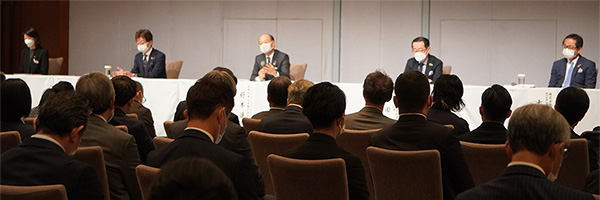
Creating a society that co-exists with the environment
-
Aiming to Achieve Net Zero by 2050
-
Environment Management System
-
Information Disclosure in Line with TCFD Recommendations
-
The Circular Economy the Group aims to create
-
Proposal for Environment-Friendly Lifestyles
-
Reduction of Wastes and Water Usage
-
Information Disclosure in line with TNFD Recommendations (Biodiversity Conservation)
-
Environmental Data
-
Acquisition of Third-Party Assurance
